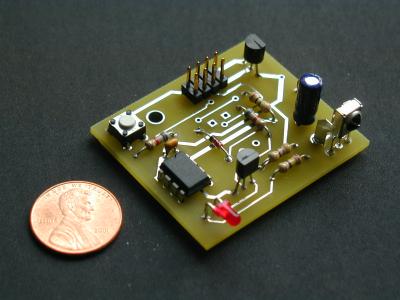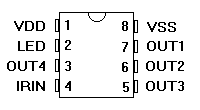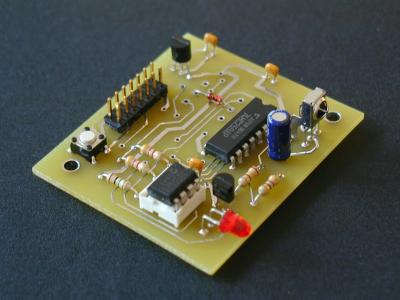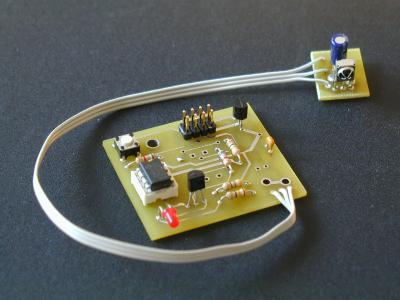TinyIR™ Learning IR Remote Control Receiver
No longer available, except as a replacement part for people who have ordered previously. Please check out TinyIR2.

Features:
- Learning - Use it with a remote you already have
- Control signals are usable directly - 4 or 8 pulse or level outputs are available
- LED indicator output - Flashes when a valid command is received
- Small size
- Chip operates from 3-5 volts DC (IR sensor used on PC-4CH, PC-8CH boards requires 4.5-5.5V)
- IR sensor can be mounted remotely, for more flexibility
- Multiple IR sensors can be connected in parallel to increase reception angle
Adding IR remote control to your next project, or to an existing one just got a whole lot easier.
With TinyIR, just apply power, train the chip to recognize the IR remote control commands you want to use, and you're ready to go. Command patterns are safely stored in internal non-volatile EEPROM. TinyIR can be re-trained many times if needed.
By installing one or two external passive components you can configure 0,1,2,3, or all 4 of the outputs as momentary, and the rest as toggle. Momentary outputs pulse high for approx 100 mSec when their command is recognized. Toggle outputs change state when their command is recognized.
If you need more than four outputs, add an expansion chip (a standard 74HC259) to get eight outputs. You can configure 0,1,2,3,4,5,6, or all 8 outputs as momentary, and the rest as toggle.
Based on an 8-pin Microchip ® PIC 12CE519 CMOS microcontroller with EEPROM, TinyIR was developed to work with most modern IR remote controls. It supports bi-phase, pulse width, and pulse position encoding techniques. All 4 or 8 codes must be in the same "family", such as a number of different keys on the same remote would be.

TinyIR Chip - $5.95
(plus small per-order
S&H fee)
(programmed, with code protect bit set)
Please download data sheet
In addition to the TinyIR chip, we offer several complete kits, containing
double-sided PC boards and all components needed to populate them.
PC-4CH Kit:
No longer available. I am out of pc bds, and don't want to order more as TinyIR2 is a newer and better design.
PC-8CH Kit:
 No longer available. I am out of pc bds, and don't want to order more
as TinyIR2 is a newer and better design.
No longer available. I am out of pc bds, and don't want to order more
as TinyIR2 is a newer and better design.
PC-RS1:

Remote IR sensor board for use with above pc boards. (Photo shows RS1 connected to four channel board.) IR sensor, and its bypass capacitor are mounted on a small pc board, which is connected to main board with a 3-conductor ribbon cable. This is useful when it is necessary to mount just the IR sensor in a location where there is insufficient space for the main board. PC-RS1 board is 0.5" x 0.75".
Since the IR sensor output is open drain with an internal pullup resistor, multiple sensors can be connected in parallel, and faced in different directions to increase reception angle. This has not been tested extensively, but we have tried a sensor on the main board in parallel with a single remote sensor board, which allowed IR signals to be recognized over a much larger angle.
PC-RS1 blank PC board - $0.95
Includes 8" 3-conductor ribbon cable. Receiver and capacitor mounting is the
same on RS1 as on the 4-CH or 8-CH boards. Please download
connection diagram.
Note: All parts needed to populate pc boards, except TinyIR chip, can be purchased at www.Digi-Key.com, or you can purchase one of our complete kits.
A word about compatibility:
TinyIR was designed to support as many different IR command formats as possible. Some manufacturers use unusual formats that are simply not supported. TinyIR is not guaranteed to work with all remote control units, but it should work with most of them. Here is more information on remotes that have been tested so far. Also, different remotes use different "modulation" frequencies. The above kits include IR receivers that are most sensitive to a modulation frequency of 38 KHz. This value was chosen to work with the widest number of remotes. If the remote is operating at a different frequency, you will get reduced range/sensitivity. The type of IR receiver used can be purchased for other modulation frequencies, if desired, at www.Digi-Key.com
DISCLAIMER: I take no responsibility whatsoever for the use and/or implementation thereof, or the misuse leading to damage to equipment, property, or life, caused by the above circuits.